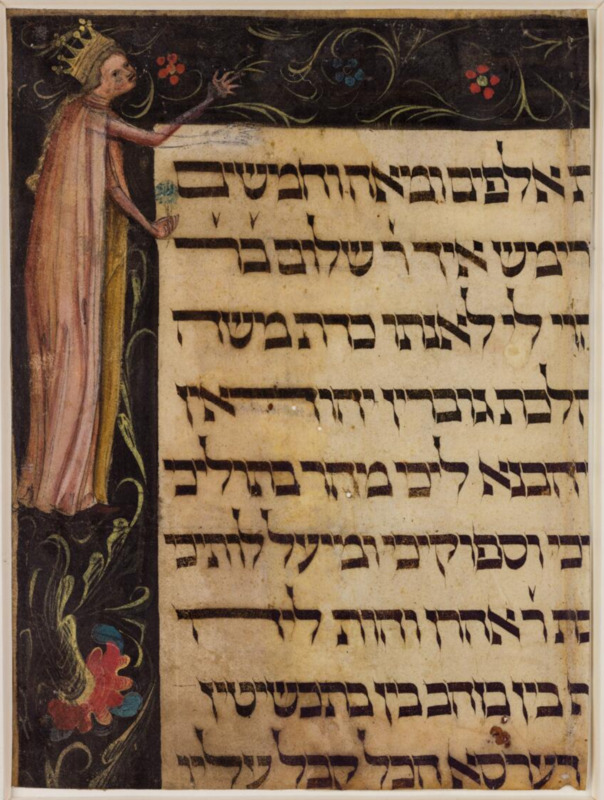Ketubbah from Krems
Type:
Illuminated manuscripts
Date:
1391/2
Location or Findspot (Modern-Day Country):
Austria
Dimensions:
upper right (groom): 28.1-28.7 × 20.3-21.1 cm,
upper left (bride): 28.3–28.5 × 20.9–21.2 cm
Description:
Four fragments survive from the oldest illustrated ketubbah, the contract (written in Aramaic) outlining the groom's obligations to his bride that is read aloud at a Jewish wedding. This ketubbah was produced in Krems, Austria, in 1391/2, and it shows that such legal documents could be elaborated with figural imagery and ornamental borders.
In the upper-right corner of the page, the groom extends an oversized ring to the crowned bride in the opposite corner. Several late medieval Jewish wedding rings are preserved. Whereas the groom's peaked hat often identifies Jews in the art of German-speaking lands, brides in medieval Ashkenaz did not wear crowns (although Byzantine Jews may have done so, just as Orthodox spouses of both sexes did and do). Crowns, however, evoked nobility and virginity, both appropriate attributes for the bride.
The couple's name is still preserved: Shalom, son of Menachem, and Zemah, daughter of Rabbi Aaron. They were married on a Friday in the Jewish year 5151, and the ceremony was witnessed by Isaac, son of the late Rabbi Gamliel (all the names are in Hebrew). Aaron may be the Aaron of Krems mentioned in a document of 1364, and Shalom probably came from a Viennese family attested in the 1380s–90s.
The Jews were expelled from Krems in 1421. The ketubbah survives in fragments because it was cut up to stiffen the binding of a volume of Christian theological texts, written on paper and dated by watermarks to 1435–40. Only small sections of the original document are missing, including the contents of the bride's dowry. Because no other illustrated ketubbot (plural) from Ashkenaz have been found, it is not clear whether this example was very unusual or whether all the others have simply been lost. Many more illustrated ketubbot survive from the sixteenth century onward, made in Italy, the Balkans, Iran, and farther east.
In the upper-right corner of the page, the groom extends an oversized ring to the crowned bride in the opposite corner. Several late medieval Jewish wedding rings are preserved. Whereas the groom's peaked hat often identifies Jews in the art of German-speaking lands, brides in medieval Ashkenaz did not wear crowns (although Byzantine Jews may have done so, just as Orthodox spouses of both sexes did and do). Crowns, however, evoked nobility and virginity, both appropriate attributes for the bride.
The couple's name is still preserved: Shalom, son of Menachem, and Zemah, daughter of Rabbi Aaron. They were married on a Friday in the Jewish year 5151, and the ceremony was witnessed by Isaac, son of the late Rabbi Gamliel (all the names are in Hebrew). Aaron may be the Aaron of Krems mentioned in a document of 1364, and Shalom probably came from a Viennese family attested in the 1380s–90s.
The Jews were expelled from Krems in 1421. The ketubbah survives in fragments because it was cut up to stiffen the binding of a volume of Christian theological texts, written on paper and dated by watermarks to 1435–40. Only small sections of the original document are missing, including the contents of the bride's dowry. Because no other illustrated ketubbot (plural) from Ashkenaz have been found, it is not clear whether this example was very unusual or whether all the others have simply been lost. Many more illustrated ketubbot survive from the sixteenth century onward, made in Italy, the Balkans, Iran, and farther east.
Relevant Textbook Chapter(s):
10
Repository and Online Resources:
• Zoom in on all four preserved pieces of the ketubbah on the website of the Österreichischen Nationalbibliothek (Austrian National Library).
• Read more about this ketubbah on the website of the Bezalel Narkiss Index of Jewish Art.
Image Credits:
Österreichischen Natinoalbibliothek




